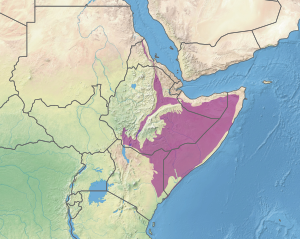Somali Acacia–Commiphora bushlands and thickets
| Somali Acacia–Commiphora bushlands and thickets | |
|---|---|
East African Oryx (Oryx beisa) in Awash National Park, Ethiopia. | |
 Map of the Somali Acacia-Commiphora bushlands and thickets ecoregion | |
| Ecology | |
| Realm | Afrotropical |
| Biome | Tropical and subtropical grasslands, savannas, and shrublands |
| Borders | List
|
| Geography | |
| Area | 1,053,300 km2 (406,700 sq mi) |
| Countries | |
| Conservation | |
| Conservation status | vulnerable |
| Protected | 10.88%[1] |
The Somali Acacia–Commiphora bushlands and thickets is a semi-arid tropical grasslands, savannas, and shrublands ecoregion in the Horn of Africa. It is home to diverse communities of plants and animals, including several endemic species.
Setting
The Somali Acacia–Commiphora bushlands and thickets ecoregion occupies most of the Horn of Africa east and south of the Ethiopian Highlands, including eastern Ethiopia's Haud plateau and adjacent parts of Somaliland, Somalia and northeastern Kenya.
It also extends along the floor of the East African Rift, bisecting the Ethiopian highlands, and along the northeastern edge of the highlands into Eritrea and Sudan.
The ecoregion is bounded on the southwest by the
Climate
The ecoregion has a
Flora
The plant communities include woodlands, shrublands, grasslands, and thickets. The predominant trees are deciduous species of Acacia and Commiphora, with a low herbaceous understory. Dactyloctenium aegyptium and Panicum turgidum are the principal grass species. Where rainfall is lower, the Acacia–Commiphora woodlands yield to low bushlands and grasslands.[2]
Fauna
The ecoregion is home to many species of gazelle, including the endemic dibatag (Ammodorcas clarkei, VU), beira (Dorcatragus megalotis, VU), hirola (Damaliscus hunteri, CR) and Speke's gazelle (Gazella spekei, VU).[2]
Protected areas and conservation
10.88% of the ecoregion is in protected areas.
References
- ^ a b "Somali Acacia-Commiphora bushlands and thickets". DOPA Explorer. Retrieved 13 November 2021.
- ^ a b c d "Eastern Africa: Eritrea, Ethiopia, Kenya, Somalia, and Sudan". Terrestrial Ecoregions. World Wildlife Fund.
